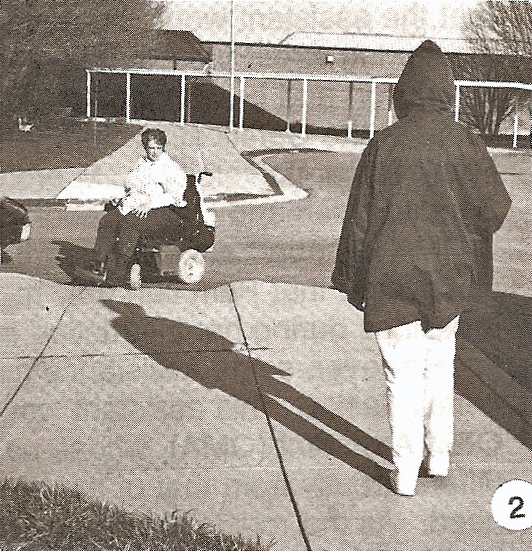Teaching O&M from a Wheelchair
by Dona Sauerburger, COMS
Spring 1995 newsletter
Metropolitan Washington Orientation and Mobility Association
As our O&M profession continues to develop with the pioneering efforts of individuals, we are indeed fortunate to have among our chapter members one of those pioneers. Pamela Matheson will probably be the first instructor to teach O&M from a wheelchair.
Pam was an O&M specialist for Howard County Public Schools in 1987 when, on her way to meet her student, an automobile accident changed her life, and she became a wheelchair user. After her recovery, she asked AER about their policy concerning O&M instructors who use wheelchairs. They asked if she'd be willing to become a test case, which she didn't feel she could do. Bitterly disappointed at being unable to continue in the profession she loved, she returned to Howard County as a vision teacher.
In the meantime, Pam became a proficient traveler in her electric wheelchair, able to steer backwards down a curb ramp, negotiate grass and rough ground easily with her wide, all-terrain wheels, and turn on a dime. When she felt that she was indeed ready to become a test case, she started the process to renew her certification to teach O&M once again.
It was an incredible coincidence that at this time, AER Division 9's Standard Certification Committee was planning its conference in Crystal City to investigate reasonable accommodations and alternate strategies that people with disabilities can use to teach O&M. Invited to the conference were blind and visually impaired instructors, and representatives of each of the university O&M programs as well as consumer and professional organizations. Committee member Dona Sauerburger, unaware of Pam's decision to re-enter the profession, invited her to participate as well.
Pam agreed. At the conference, she demonstrated her adaptive techniques and brainstormed with participants to develop strategies to teach O&M from her wheelchair. One adaptive technique that was tried was the use of an assistant to monitor students while Pam teaches them to negotiate stairs and other aspects of O&M. Pam had first thought that the assistant would be needed extensively for monitoring street crossings, but through simulated instruction and brainstorming with Elga Joffee (Co-Chair of the Certification Standards Committee), Frank Ryan, university O&M program coordinators Sandy Rosen and Dawn (Igbokidi) Lowery (a former WOMA member) and other participants, it was discovered that Pam can ably monitor most street crossings during her instruction herself.
However, some assistance may be needed for certain tasks. This assistant would not be a trained O&M Assistant (OMA), whose narrowly defined role differs greatly from that of the assistant Pam would need. As the role is envisioned now, Pam's assistant would provide no instruction, but would only monitor and intervene for the students' safety. In all likelihood, the assistant could be a teacher's aid who would learn from Pam the procedures needed to monitor and intervene, and the vocabulary and signals that Pam would use to direct him or her. The assistant would then accompany Pam only on lessons during which assistance would be needed (such as when the student is learning to use stairs, and at places where there are insufficient curb cuts for Pam to maneuver where needed during the student's street crossings). Adaptive devices might include one like the Easy Listener to communicate readily with the assistant.
A theme that emerged from the conference is that instructors with disabilities often structure their initial lessons in ways that allow them to teach and monitor their students, as do all instructors. For example, Pam would probably begin instruction for stair travel at a single stair or curb where she could provide her own hands-on instruction and monitoring. She might then have the student advance to a portable 2- or 3-step stairway, such as is used by physical therapists, where again she can be beside the student and reach him or her. When their cane technique and balance have been established through this training, students would be ready for Pam to instruct them on full stairways while the assistant follows them up the stairs and precedes them down the stairs to monitor for safety, in the same manner as would a non-disabled O&M instructor. When the student's stair skills become well established such that any O&M instructor would step back and allow independent travel, the need for the assistant would end. This would provide Pam's students with exactly the same degree of protection and coverage as students of non-disabled O&M instructors have.
Pam has applied for a position as O&M instructor with her school system. We wish her well as she pioneers strategies for teaching O&M.
___________________________________________
Included in the article were pictures of Pam monitoring a student, which are scanned below; caption was: "During street crossings, Pam easily maneuvers her chair to keep between the traveler and the traffic in such a way that she can grasp the traveler whenever necessary."




Return to Home page



